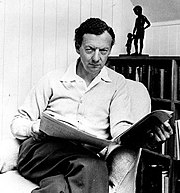Benjamin Britten's Human Design Chart
6/2 Emotional Manifesting GeneratorBritish foremost composer who helped revive interest in opera through his “Peter Grimes,” 1945 and other works, including compositions for motion pictures.
He studied and from age seven and from age 14, composed music that was straightforward and conservatively modern with a dramatic flair. In 1937, then 24 years old, he made his mark outside England with the premiere at the Salzburg Festival of his “Variations on a Theme of Frank Bridge,” a work of stunning brilliance.
The son of a dentist, Britten was raised in the seaside town of Lowestoft. He went to boarding school and later fell into the raffish company of W.H. Auden and Christopher Isherwood in the London ’30s. According to his letters, the gay writers took him to bath houses and urged him “to decide something about my sexual life.” Neither was able to crack his physical reserve, nor was his relationship with the tenor Peter Pears consummated until they reached a hotel in Grand Rapids, Michigan, in June 1939.
For most of Britten’s life, homosexual contact between consenting adults was an imprisonable offense. It was during Britten’s time in America during World War II that his relationship with Pears deepened to become a nearly 40-year partnership. They were baited by homophobes among their colleagues and taunted by other musicians over their pacifism and socialism. Becoming hyper-sensitive to criticism and paranoid about his privacy, Britten was a timid but deeply ambitious man, fortified in his resolve by the two people who loved him most, his mother and his lover. When his adored and adoring mother died in 1937, he lost “the grandest mother a person could have.” It was within weeks that Pears entered his life. It was noted that Pears, a lyric tenor, had a voice “exactly like Britten’s mother.”
Pears was the active partner, and the one with a roving eye. Britten never wavered in his devotion and was often fearful that his lover may stray, though his love was essentially more emotional than carnal. Theirs was a unique melding of talent and Britten specifically instructed Mitchell “to tell the truth about Peter and me.”
Benjamin Britten died of congestive heart failure on 4 December 1976 at age 63. On 20 June 1991, his intimate letters and diaries were published, but gingerly, because he had shared most of his adult life with Pears. The materials were suppressed by Britten’s lover and nervous trustees of his estate, but after Pears’ death in 1986, the eminent Mahler scholar Donald Mitchell was given permission to edit the correspondence. A close friend and the composer’s publisher for 13 years, Mitchell co-edited the work, titled, “Letters From a Life: Selected Letters and Diaries of Benjamin Britten,” in three volumes.
Link to Wikipedia biography
Discover More Famous People
Browse and analyze over 55,000 public figures and celebrities.
Ra Uru Hu
5/1 Manifestor
Martha Stewart
4/6 Manifestor
David Lynch
4/6 Generator
Barack Obama
6/2 Projector
Steve Jobs
6/3 Generator
Vladimir Putin
5/1 Manifestor
Kim Kardashian
3/5 Generator
Michael Jackson
1/3 Projector
Marilyn Monroe
6/2 Projector
Ariana Grande
2/4 Projector
Oprah Winfrey
2/4 Generator
Johnny Depp
2/4 ManifestorWhat is HumanDesign.ai and how does it work?
Curious what makes Benjamin Britten tick? HumanDesign.ai instantly maps their exact birth data into a fully interactive clickable bodygraph chart, letting you hover or tap every center, channel, and gate for plain-language explanations. Bella, the platform’s built-in AI guide, adds context in real time, translating complex mechanics into everyday insights so you can see how Benjamin Britten’s strengths, challenges, and life themes play out on-screen.
The same tools are waiting for you. Generate your own Human Design Chart in seconds, open a library of 2000+ suggested questions, and chat with Bella as often as you like to decode your design, daily transits, and even relationship dynamics.
Want to compare energies? Save unlimited charts for friends, family, or clients, then ask Bella to reveal compatibilities, composite patterns, or coaching tips, all in one conversation thread.
Start free with core features, or unlock our Personal and Pro plans for deeper dives: unlimited Q&A, celebrity chart search spanning 55,000+ public figures, white-label PDF reports, branded content generation, and a professional profile with built-in booking for practitioners. Whether you’re exploring your own potential or guiding others, HumanDesign.ai delivers an ever-expanding toolbox of AI-powered insights—no spreadsheets, no jargon, just clarity at your fingertips.
Ready to see yours? Signup for FREE today!

